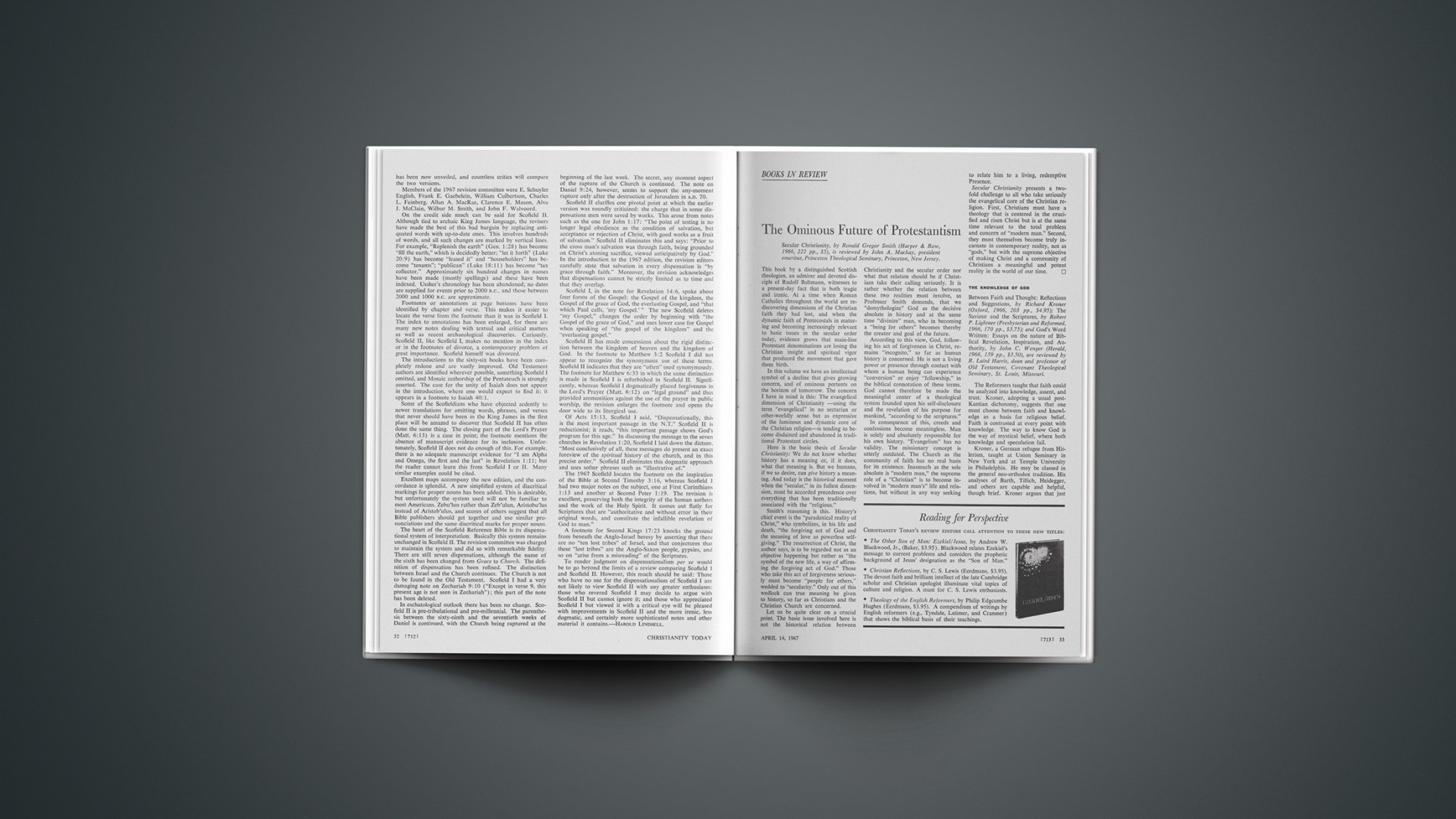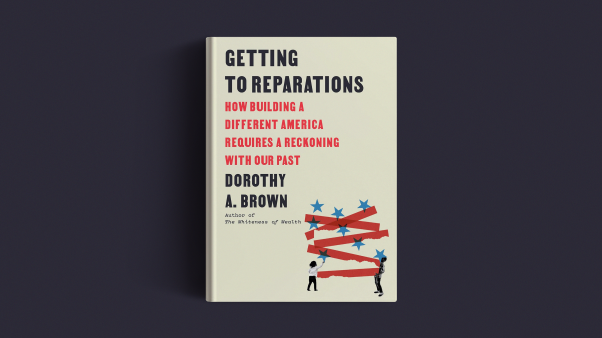Cyrus I. Scofield was born in Michigan in 1843 and died on Long Island, New York, in 1921. A lawyer admitted to the Kansas bar, he was appointed United States attorney for Kansas by President Grant. That same year he experienced a dramatic conversion and began intensive study of the Bible, and in 1882 he became minister of the First Congregational Church of Dallas, Texas. Later he was minister of the Congregational Church of Northfield, Massachusetts, and president of the Northfield Bible Training School, at the insistence of his fast friend Dwight L. Moody.
In 1902 Scofield retired from the pastorate and for seven years gave himself to the production of the reference Bible published in 1909 and then revised in 1917. Oxford University Press was its United States publisher, and it has sold more copies than any other title issued by that press in the States. The Scofield Bible has encouraged tens of thousands of people to study the Scriptures dispensationally and intensively. Even thousands who have not embraced Scofield’s dispensationalism have been blessed by a wealth of other material useful to Christians of various theological persuasions.
The Scofield Reference Edition of the Bible has been a formidable if not determinative force in fundamentalism for more than fifty years. When Oxford announced a revision was on its way, rumblings from Scofield admirers could be heard from Boston to Bombay. To some, change was unthinkable. Indeed, with several million copies in print, the Scofield Bible had attained an almost impregnable position in the hearts of multitudes. But the “new” Scofield has been now unveiled, and countless critics will compare the two versions.
Members of the 1967 revision committee were E. Schuyler English, Frank E. Gaebelein, William Culbertson, Charles L. Feinberg, Allan A. MacRae, Clarence E. Mason, Alva J. McClain, Wilbur M. Smith, and John F. Walvoord.
On the credit side much can be said for Scofield II. Although tied to archaic King James language, the revisers have made the best of this bad bargain by replacing antiquated words with up-to-date ones. This involves hundreds of words, and all such changes are marked by vertical lines. For example, “Replenish the earth” (Gen. 1:28) has become “fill the earth,” which is decidedly better; “let it forth” (Luke 20:9) has become “leased it” and “householders” has become “tenants”; “publican” (Luke 18:11) has become “tax collector.” Approximately six hundred changes in names have been made (mostly spellings) and these have been indexed. Ussher’s chronology has been abandoned; no dates are supplied for events prior to 2000 B.C., and those between 2000 and 1000 B.C. are approximate.
Footnotes or annotations at page bottoms have been identified by chapter and verse. This makes it easier to locate the verse from the footnote than it was in Scofield I. The index to annotations has been enlarged, for there are many new notes dealing with textual and critical matters as well as recent archaeological discoveries. Curiously, Scofield II, like Scofield I, makes no mention in the index or in the footnotes of divorce, a contemporary problem of great importance. Scofield himself was divorced.
The introductions to the sixty-six books have been completely redone and are vastly improved. Old Testament authors are identified wherever possible, something Scofield I omitted, and Mosaic authorship of the Pentateuch is strongly asserted. The case for the unity of Isaiah does not appear in the introduction, where one would expect to find it; it appears in a footnote to Isaiah 40:1.
Some of the Scofieldians who have objected ardently to newer translations for omitting words, phrases, and verses that never should have been in the King James in the first place will be amazed to discover that Scofield II has often done the same thing. The closing part of the Lord’s Prayer (Matt. 6:13) is a case in point; the footnote mentions the absence of manuscript evidence for its inclusion. Unfortunately, Scofield II does not do enough of this. For example, there is no adequate manuscript evidence for “I am Alpha and Omega, the first and the last” in Revelation 1:11; but the reader cannot learn this from Scofield I or II. Many similar examples could be cited.
Excellent maps accompany the new edition, and the concordance is splendid. A new simplified system of diacritical markings for proper nouns has been added. This is desirable, but unfortunately the system used will not be familiar to most Americans. Zebu’lun rather than Zeb’ulun, Aristobu’lus instead of Aristob’ulus, and scores of others suggest that all Bible publishers should get together and use similar pronunciations and the same diacritical marks for proper nouns.
The heart of the Scofield Reference Bible is its dispensational system of interpretation. Basically this system remains unchanged in Scofield II. The revision committee was charged to maintain the system and did so with remarkable fidelity. There are still seven dispensations, although the name of the sixth has been changed from Grace to Church. The definition of dispensation has been refined. The distinction between Israel and the Church continues. The Church is not to be found in the Old Testament. Scofield I had a very damaging note on Zechariah 9:10 (“Except in verse 9, this present age is not seen in Zechariah”); this part of the note has been deleted.
In eschatological outlook there has been no change. Scofield II is pre-tribulational and pre-millennial. The parenthesis between the sixty-ninth and the seventieth weeks of Daniel is continued, with the Church being raptured at the beginning of the last week. The secret, any moment aspect of the rapture of the Church is continued. The note on Daniel 9:24, however, seems to support the any-moment rapture only after the destruction of Jerusalem in A.D. 70.
Scofield II clarifies one pivotal point at which the earlier version was roundly criticized: the charge that in some dispensations men were saved by works. This arose from notes such as the one for John 1:17: “The point of testing is no longer legal obedience as the condition of salvation, but acceptance or rejection of Christ, with good works as a fruit of salvation.” Scofield II eliminates this and says: “Prior to the cross man’s salvation was through faith, being grounded on Christ’s atoning sacrifice, viewed anticipatively by God.” In the introduction to the 1967 edition, the revision editors carefully state that salvation in every dispensation is “by grace through faith.” Moreover, the revision acknowledges that dispensations cannot be strictly limited as to time and that they overlap.
Scofield I, in the note for Revelation 14:6, spoke about four forms of the Gospel: the Gospel of the kingdom, the Gospel of the grace of God, the everlasting Gospel, and “that which Paul calls, ‘my Gospel.’ ” The new Scofield deletes “my Gospel,” changes the order by beginning with “the Gospel of the grace of God,” and uses lower case for Gospel when speaking of “the gospel of the kingdom” and the “everlasting gospel.”
Scofield II has made concessions about the rigid distinction between the kingdom of heaven and the kingdom of God. In the footnote to Matthew 3:2 Scofield I did not appear to recognize the synonymous use of these terms. Scofield II indicates that they are “often” used synonymously. The footnote for Matthew 6:33 in which the same distinction is made in Scofield I is refurbished in Scofield II. Significantly, whereas Scofield I dogmatically placed forgiveness in the Lord’s Prayer (Matt. 6:12) on “legal ground” and thus provided ammunition against the use of the prayer in public worship, the revision enlarges the footnote and opens the door wide to its liturgical use.
Of Acts 15:13, Scofield I said, “Dispensationally, this is the most important passage in the N.T.” Scofield II is reductionist; it reads, “this important passage shows God’s program for this age.” In discussing the message to the seven churches in Revelation 1:20, Scofield I laid down the dictum. “Most conclusively of all, these messages do present an exact foreview of the spiritual history of the church, and in this precise order.” Scofield II eliminates this dogmatic approach and uses softer phrases such as “illustrative of.”
The 1967 Scofield locates the footnote on the inspiration of the Bible at Second Timothy 3:16, whereas Scofield I had two major notes on the subject, one at First Corinthians 1:13 and another at Second Peter 1:19. The revision is excellent, preserving both the integrity of the human authors and the work of the Holy Spirit. It comes out flatly for Scriptures that are “authoritative and without error in their original words, and constitute the infallible revelation of God to man.”
A footnote for Second Kings 17:23 knocks the ground from beneath the Anglo-Israel heresy by asserting that there are no “ten lost tribes” of Israel, and that conjectures that these “lost tribes” are the Anglo-Saxon people, gypsies, and so on “arise from a misreading” of the Scriptures.
To render judgment on dispensationalism per se would be to go beyond the limits of a review comparing Scofield I and Scofield II. However, this much should be said: Those who have no use for the dispensationalism of Scofield I are not likely to view Scofield II with any greater enthusiasm: those who revered Scofield I may decide to argue with Scofield II but cannot ignore it; and those who appreciated Scofield I but viewed it with a critical eye will be pleased with improvements in Scofield II and the more irenic, less dogmatic, and certainly more sophisticated notes and other material it contains.—HAROLD LINDSELL.










